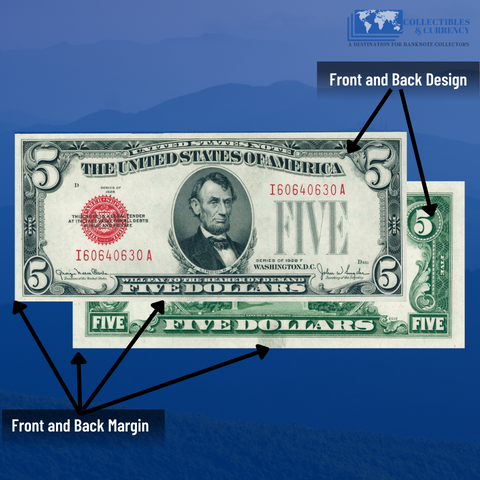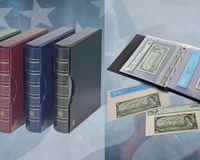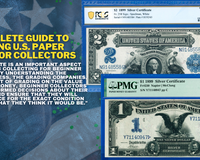Collecting U.S. Paper Money is a fascinating hobby for many people who appreciate the history, design, and rarity of notes. Whether you are a seasoned collector or just starting out, it is important to understand the various factors that contribute to the value of a note. One of the most critical factors is the condition of the note, which is why currency grading is a crucial aspect of paper money collecting.
In this guide, we will take a closer look at the grading process and provide a detailed explanation of the different grading systems used to evaluate the condition and value of U.S. paper money. Whether you are looking to sell your collection or simply want to understand its worth, this guide will provide you with a comprehensive understanding of the grading process.
What kinds of criteria need to be considered when grading a raw note?
When grading U.S. paper money, it is important to consider several factors, including centering, wear and tear, ink quality, corners, tears, and overall appearance. Here is a breakdown of the key criteria to consider when grading a U.S. paper money note.

- Centering: The centering of the note refers to how well the design is centered on both the front and back of the note. A note with perfect centering will receive a higher grade than a note with poor centering.
- Margins: This includes the borders of the note and the white space surrounding the design.
- Ink Quality: The quality of the ink on the note is also important in grading. A note with clean, bright, and sharp ink will receive a higher grade than a note with dull or faded ink.
- Paper Quality: This includes the texture, brightness, and crispiness of the paper material.
-
Wear and Tear: Wear and tear is another important factor in grading a note. The less wear and tear a note has, the higher its grade will be. A fold is a crease that is caused by bending or folding a note. FOLD CAN GREATLY AFFECT THE CONDITION OF A NOTE AND ARE A MAJOR CONSIDERATION IN THE GRADING PROCESS. THE MORE FOLDS A NOTE HAS, THE LOWER ITS GRADE IS LIKELY TO BE. Folds that are deep, heavy, or go through the design elements of a note will lower its grade more significantly than lighter, less noticeable folds.
For example: A note with a single light fold may still be considered to be in about uncirculated condition, while a note with three or more heavy folds may only be considered to be in Extremely Fine condition. It is important to remember that the number of folds is not the only factor in determining the grade of a note, but it is a significant consideration that can greatly impact its condition. - Issue: Staining, Rusting, Missing Pieces, and Tearing. Tearing is a common issue that can significantly lower the value of a note. It's important to examine the note carefully for any signs of tearing, including small or large tears, and to determine the extent of the damage.
Various terms that assigned the condition of the note
Grading a raw note when you bought from the dealer involves evaluating its overall condition and assigning various terms to describe its condition. Here is a detailed explanation of some of the most commonly used terms to describe the condition of a note. This grading standard is based on the criteria that were mentioned above.
- Gem Uncirculated: A note that is considered near-perfect. There is no sight of circulation. With only minor imperfections, such as slight ink smudging or centering that is not quite as sharp as a Super Gem Uncirculated note.
- Uncirculated: A note that has not been used in circulation, but may have minor imperfections, such as a slightly off-center design or light handling.
- Choice About Uncirculated: A note with light circulation but still remain its paper crispiness. It may have minor imperfections, such as only one light fold.
- About Uncirculated: A note with moderate circulation, but still retains a clear design. It may have more signs of circulation. Usually a destination for the note with two hard vertical folds.
- Choice Extremely Fine: A note with a sharp design, but with more signs of circulation than the About Uncirculated. Usually a destination for the note with three hard vertical folds or one fold for vertical and horizon on each side.
- Extremely Fine: A typical note arrived at this condition will have three to four heavy folds one of them can be a horizon fold with minimal wear and excellent eye appeal.
- Choice Very Fine: A note with a clear design, but with more significant signs of circulation, there might be greater than 4 and less than 7 folds or wrinkles but still retain its crispness.
- Very Fine: A note with a clear design, but with even more significant signs of circulation, such as heavy creases or folds. There might be from 7 up to 10 folds.
- Choice Fine: A typical example of a note with heavy circulation. Can be assigned at Very Fine but there are many overlapping folds under the light source which prevent it to achieve VF.
- Fine: Refers to a note that has heavy wear. Tears, pinholes, missing a part, or corners worn out can be a sight of heavy circulation.
A reference condition example with pictures from Gem Uncirculated to Fine condition.





What is the grading standard used by the biggest grading companies?
PMG (Paper Money Guaranty) and PCGS Banknote Grading (Professional Coin Grading Services) are third-party leading grading companies that provide a more comprehensive evaluation of the condition and quality of the note. When it comes to assigning grades, PMG/PCGS Banknote Grading considers the same criteria which were mentioned above such as centering, margin, wear and tear, and overall appearance. The assigned grade is based on strict standards and guidelines, providing collectors with a trustworthy and impartial evaluation of their notes.
They use a numerical grading system ranging from 1 up to 70, but with more detailed grading criteria and a higher level of expertise with 70 being the highest grade. A grade of 70 means that the currency is in perfect condition centering and margin, with no signs of wear or damage, while a grade of 1 means that the currency is extremely worn and in poor condition.
After the note was assigned the score. The note will be encapsulated and well protected in a holder with the assigned grade and other information of the note printed on the top label. Each note will come up with a barcode. The note’s grade, image, and other information are listed in their online population report system for future reference.

Using a third-party grading company like PCGS or PMG is important because it provides an unbiased assessment of the note. A professional grader has the expertise and experience to accurately determine the condition of a note, which can greatly affect its value. Additionally, grading companies like PCGS and PMG use strict standards and procedures to ensure the authenticity of the items they grade.
PMG and PCGS Banknote Grading are widely recognized and trusted by collectors and dealers. By using a reputable grading company, collectors and dealers can have confidence in the accuracy and authenticity of notes, which can help them make informed buying and selling decisions. Furthermore, items that have been graded by PCGS or PMG are recognized and accepted by the numismatic community, making them easier to sell and trade.
There are certainly advantages to using a grading service for collectors, but it is essential to be cognizant of the potential difficulties that come along with it. One of the most significant difficulties is the financial cost. This includes an annual membership fee as well as a grading fee for each note submitted. The grading fee covers the cost of assessment and encapsulation, while the membership fee gives collectors access to the grading services and other perks provided by the grading companies.
Another challenge with grading services is the waiting period, which can be quite lengthy. The evaluation and encapsulation process can take several months, causing frustration for collectors who are eager to have their notes graded. The waiting time is dependent on the grading company and can vary, but the wait can be substantial for those who are eager to have their notes protected and evaluated.
Grading a note is an important aspect of numismatic collecting for beginner collectors. By understanding the grading process, the grading companies, and the impact of grading on the value of U.S Paper Money, beginner collectors can make informed decisions about their collection and ensure that they will pay a fair price for the exact condition of the note that they think it would be. Whether you are a seasoned collector or just starting out, it is always a good idea to familiarize yourself with the grading process and understand why it is so important. With the right knowledge and resources, you can build a valuable and meaningful collection that you can enjoy for years to come.









24 comments
Sofia Freitag
I have a $2 dollar bill in good condition and
Series dated 1976. Is it worth anything.
Also I have a $2 dollar bill that all corners front and back say it value is $2 .
Can you tell me their worth if anything?
Samuel valadez
I have a crisp 20 dollar bill with s/n 00000271 is it worth anything?
robert hooe
I have a $1 bill printed on the pink paper like the $5 bill… Worth anything???
Jin
You people who have questions about your collections need to join a FB group. You get plenty of answers that way. You will also learn what to look out for.
Harold A. Curtiss
I have a 1974 $1 Federal Reserve note with solid serial numbers in mint condition
John
I have seven new Series 2017A $100 bills that have sequential serial numbers running from PB35624579K to PB35624584K. Are they collectible and do they have any value?
Mary Pagan Maxwell
I have some $20 bills and the year only want to the Year 2007 p e p a i k m c 2003 2009 2007 2013s are they worth anything all the numbers match from the left to the right let me know with a comment on my email
Mary Pagan Maxwell
I live in Florida Miami Florida I have some $20 bills and some $5 bills and I would like to know all of them have matching numbers on them I would like to know are they worth anything they’re all 2013 and 2017
Johnny
Be on the lookout for 2013B star notes. More info at Project 2013B
Kent Williams
I have a dollar bill with no serial numbers on it. Everyone that’s looked at it feels it’s authentic. Would their be a value to it?
Samantha
I have a starnote,with 1 of the stars filled.should I get it graded?
Richard
I have a $100 dollar bill with a almost solid serial number of PB88808888E in crisp condition. What is the value of this note?
Becky
I have 10 – $1 bills – Blue Seal Silver Certificates in sequential order – Perfect condition – 1957 series – Number from W83836784A thru W83836793A. I would like to know what they are worth. What would it cost to have them graded?
Jenny
Playful letters dance, forming stories, unlocking knowledge, sparking joy – word games unite minds worldwide. https://playwordgames.org
Peter George
Hello. Good evening. My name is Peter and I have 3 star notes and I want to grade them. What must I do to get the star notes graded?
Rich
Monkey Mart: A fun-filled virtual store adventure! Manage a bustling shop, cater to adorable customers, and conquer entertaining puzzles for an enjoyable gaming experience. https://quillfulgames.com/monkey-mart
Johnny
Phrazle game: A brain-teasing word puzzle fostering language mastery and providing hours of enjoyable gameplay for players worldwide. https://phrazle.website
Phil
I have some $1, $20 & $100 bills from 0-8 serial number but not in order. Is it worth to keep?
Michael
$1. D. Bill
Michael
I have a $1. Bill it has # ofaC22000099E What’s it worth? Very goodcondition.
John berry
I have a dollar bill serial #85555374 and 94494470. Could they be worth anything?
Virginia
I have a 3013 dollar bill with a serial number the # 88440033
J1HEART
I have a new $100 bill with a serial# 77222225 is it valuable?
Maria L Blanco
I have same dollar